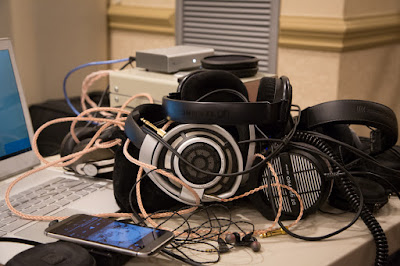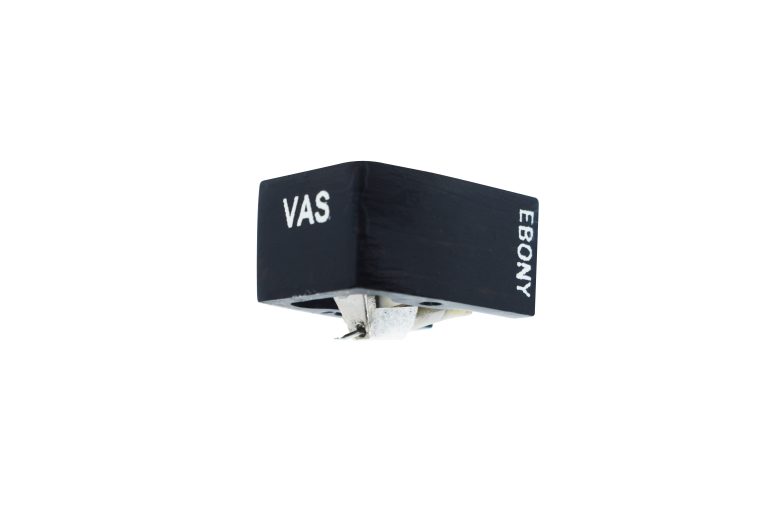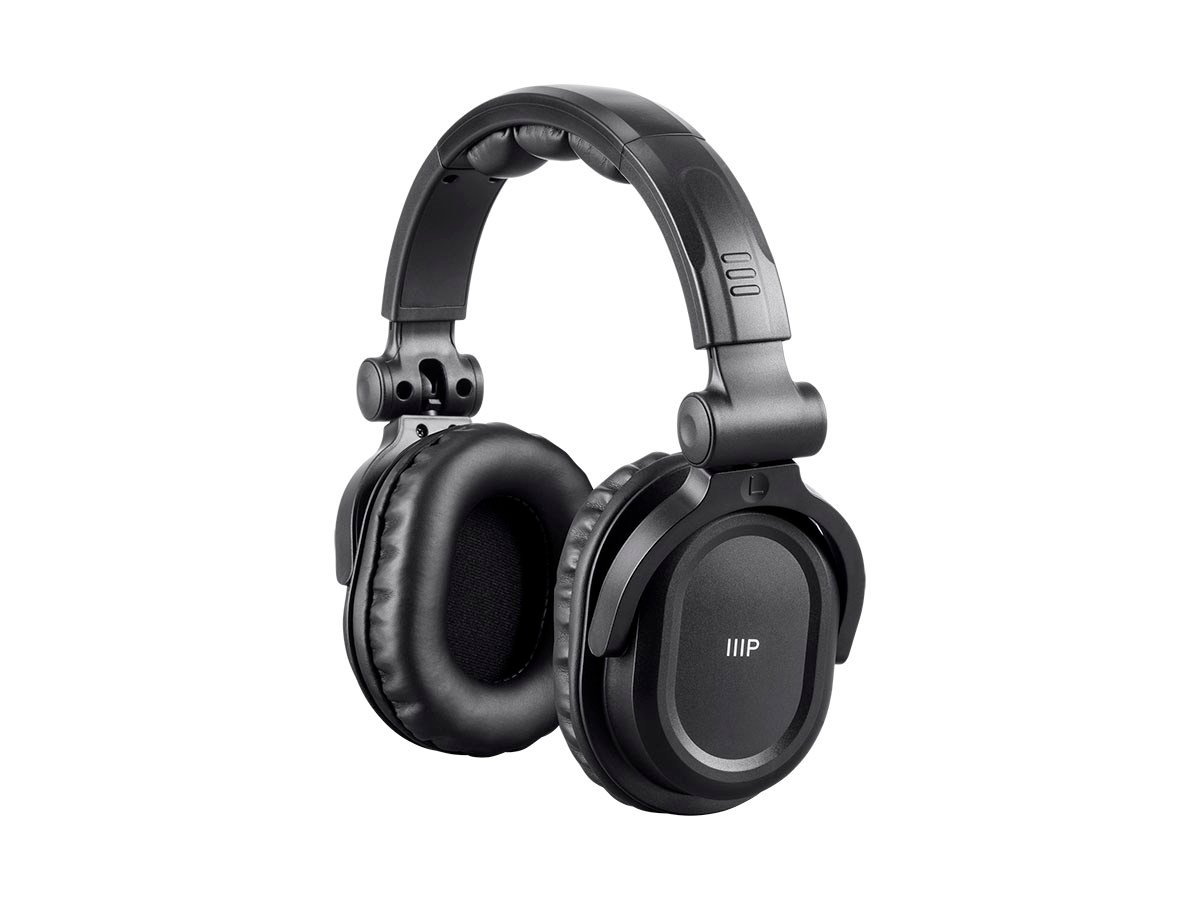From mrgoodsound: Follow-up Thoughts On Headphone Listening
This is a Part II post. For Part I, please see here.
For this post, I would like to share some philosophy on what makes headphone listening engaging to me, and provide some context with my own headphone experience.
The X Factor
Before I begin, I'd like to state that I do experience 'goosebumps', 'shivers' or 'frisson' from auditory stimuli, including hearing the right music on a 'good' system. I open with this because from what I understand this physical reaction to sound is unique to each individual and not everyone experiences this, or experiences it the same way.
All audiophiles have individual 'sounds' that they are looking (listening?) for whenever they audition a system or individual component. These 'sounds' are more felt as much as they are heard, and the enthusiast knows if system Y or component Z has 'it', even if they cannot express 'it' in words their colleagues will understand. Often as their colleagues are listening for their own 'sounds'. To simplify, I will just call the presence of these 'sounds' the X factor.
I wouldn't be able to effectively communicate in words my personal X factor to the reader for multiple reasons, the biggest of which is the shared vernacular we audiophiles use to discuss sounds has some words so completely diluted by the mainstream press and the un-experienced that they have become meaningless. Instead my goal is to give some ideas of what I am looking for in a good headphone system, in order to achieve goosebumps. I think this is important to discuss, because I spent so much time, money and frustration trying to obtain the correct balance of these traits.
- Tonality/timbre: Unfortunately there is a disturbing trend in the high-end headphone market to sacrifice even response or natural timbre for lightning fast transient response and shoving macro-detail into your face (literally). Admittedly, it is difficult to begin with to get a driver smaller than your palm firing directly at your ear from millimeters away to produce anything resembling a linear response. In a speaker system, I can actually be more forgiving of vulgarities from metal domes and HF horns in exchange for liveliness and immediacy. With headphones, I do not feel the trade off is as worth it, and avoiding fatigue takes higher priority. Focal comes to mind as an offender, as I cannot listen their Utopia ($4000) or Clear ($1500) models for more than a few tracks without serious fatigue from metallic timbre and overemphasized leading edge transients.
- Imaging: In my opinion precision imaging is very overrated in all forms of sound reproduction. Of course with headphones the acoustic interaction of a listening room is not part of what reaches your ear-brain system, and we get a presentation similar to near-field monitors, albeit even more intimate. But who wants to focus with laser precision on tiny instruments on a tiny stage inside their head? My favorite headphone systems have generally been a bit diffuse or even 'smeared' with how aural images are spread out.
- Soundstage: Headphone listening can be described as intimate for a number of reasons. I will say that I dislike headphone systems that sound too 'in-your-head'. We are talking about a few millimeters here, but the best systems I've heard were able to project a sound-field slightly in front of my eyes, with a teeny tiny bit of front-to-back depth. This is in contrast to a flat plane of sound inside my head, behind my eyeballs. The latter is what is typical from even very expensive solid-state headphone amplifiers, the headphone outs of receivers, integrated amps, and CD players.
- Euphony: It is highly desirable for me to have a headphone system to lean towards 'euphony'. This is a cop-out descriptor I admit, a lot like 'musical', it doesn't mean much by itself. But to achieve a mouth-open-drooling-stupor listening session, I want music to be played through my headphones imbued with a bit of richness or saturation of tone, that I don't necessarily 'need' in a two-channel system to stay interested. So far I have only achieved satisfaction in this area with models from Sennheiser, AudioTechnica, ZMF, and certain vintage Stax (only with un-amplified acoustic material).
Practical Headphone Advice Based On Experience
Over the past few years I have squandered my fair share of money on headphones and headphone amplifiers trying to chase a type of sound I formulated in my head (that I never quite reached). I really don't want to present myself as any sort of expert, and I try in general to avoid dogmatic thought now more than ever. However I have formed very strong opinions after several years and the below encapsulates my thoughts (read: biases) on the various types of headphone gear available on the market, broken down by driver type/manufacturer.
Dynamic Headphones
I am heavily biased to dynamic driver (moving cone) headphones.Sennheiser: For me, the undisputed king of the hill is the Sennheiser HD600/650 (doesn't matter which, I like them both equally). They win at linearity from the lower mids through the presence region, have above average resolving ability and as such service all genres of music. These models have been around for ages, can be modified to slightly improve performance past stock and are available at prices anyone can afford. Their high-impedance voice coils make them suited to what I believe is the ideal amplifier topology for headphones, output transformer-less valve amplifiers. I do not care at all for the HD800, which is perhaps the most overrated headphone of all time.
ZMF: Relative newcomer, as they have released several models that have become very popular in recent years. Also using high-impedance dynamic drivers, and besting the Sennheiser HD600 in several technical areas such as bass extension and cleanliness of transients. My opinions vary on their models from strong dislike (Eikon) to like (Auteur). Ultimately I find them to be too expensive for what they are and the approach of using wooden enclosures as a tuning mechanism not ideal, but novel. I really understand why they have a strong fan base though, it is deserved for at least having a unique approach which works to taste.
Focal: Strong dislike. All of their models retain irregular, metallic timbre with vulgar overtones on string instruments. Very comfortable and well built.
Audio-Technica: Unfortunately, only their discontinued models are worth the time of day, many of which are fetching collectors prices on the second-hand market now. They frequently have 'Japanese' tuning which is far from neutral but suites certain genres. The best models have emphasis on fast transient response and airy but warm sound. I really like AD-2000.
Headphone bonanza from 2017 Toronto meet-up.
Electrostatic Headphones
These are supposed to be the 'most advanced' headphones, using ultra-thin membranes which are electrically energized to produce sound. I had attended a headphone enthusiast meet-up several years ago in which I heard all the modern Stax models, many vintage units, and several expensive electrostatic amplifiers. Based on this experience, I had written off electrostats as wispy and limp sounding and unable to cope with electric music. This opinion persisted until very recently.
Stax: I dislike the SR-009 and SR-007 mkII based on my listening experiences at the aforementioned meetup and again at a dealer in Toronto with Stax's own recommended energizer units. I recently acquired from a friend three vintage Stax models, the SR-3, New SR-3, and SR-5; as well as the SRA-12S integrated earspeaker amplifier/pre-amplifier, which has changed my opinion. These very early units (1970s) have thicker diaphragms versus the ultra-thin modern models, and trade some transient response for a warmer sound with a bit more heft, a bit more euphony. I still find them largely allergic to electric music, but they impress with jazz and chamber music. I will write more on these models and the SRA-12S (a very interesting unit indeed) in a separate post.
Stax SRA-12S amp + SR-5 headphones. One of the best headphone setups I have heard.
Sennheiser: I had the opportunity to hear the HE-60, with its own drive unit and several electrostatic amplifiers. It is the real deal, too laid back for my taste but again absolutely charming with acoustic music. Unfortunately these are becoming very difficult to find in good condition and fetch collectors prices.
From what I understand speaking with individuals more experienced with owning electrostatic headphones than I, the real issue with building a 'good' electrostatic system is a shortage of 'good' electrostatic amplifiers/energizer units. From what I can tell, Stax themselves have manufactured a grand total of two amplifiers which were all tube-based from input to output. Their modern models are all hybrids, either with FET input and triode output or vice versa. The most popular 'high-end' commercial offerings are solid-state. There are very few all tube-based units, many of which are cost prohibitive and fewer still employing DHTs.
Orthodynamic (Planar) Headphones
To date I am wholly unimpressed with this category of headphones. I feel that orthodynamic headphones have too many compromises in vital areas of sound and tend to homogenize music more than electrodynamics or electrostatic types.Audeze/Hifiman: These two companies are really two sides of the same terrible coin. They engage in anti-consumer practices such as price creep, product variation, silent revisions, terrible quality control and shoddy customer service. They release new models every few months with minuscule tuning differences, but slowly and surely increasing the prices. Two pairs of the same Audeze model can sound drastically different, with variations of up to a few dB in published, repeated measurements. Hifiman all follow virtually the same tuning, with a depressed presence region and bump in the lower treble that I do not like at all. Their most expensive models don't do much to distinguish from the inexpensive ones.
MrSpeakers: Very well built and very comfortable. Strong dislike. Completely dead, dull, lifeless. Frequently releases new models with minor engineering revisions for higher prices, ruining resale for existing owners who did not even have the latest model for 6 months. Has recently re-branded to Dan Clark Audio.
In terms of sound, I find all of the orthodynamics I have experienced thus far homogenize too much in too many areas of reproduction including dynamic compression, lack of micro-dynamic expressiveness and very colored presence to brilliance regions. Orthodynamics are also traditionally hungry for current and recommended to pair with solid-state amplifiers. They will not respond to output transformer-less valve amps. Their main sonic advantage is deep bass extension with low harmonic distortion, which is on the bottom of my personal priority list. The only plus side I can think of is that these two brands have extensive distribution and dealer networks, so most living in metropolitan areas can audition before buying. Perhaps the tuning or presentation will agree with you, or you primarily listen to electronic music where deep bass is a priority, and the pricing on an open box or 'demo' unit will make sense. I cannot really recommend these though for the reasons stated above.
A visual summary of the above paragraphs.
On Headphone Amplifiers
Until then, Happy New Year and thanks for reading!




























:format(jpeg):mode_rgb():quality(40)/discogs-images/R-11120161-1510224147-1708.jpeg.jpg)
:format(jpeg):mode_rgb():quality(40)/discogs-images/R-1947022-1402895779-4182.jpeg.jpg)
:format(jpeg):mode_rgb():quality(40)/discogs-images/R-2278966-1452018645-9592.jpeg.jpg)


:format(jpeg):mode_rgb():quality(40)/discogs-images/R-8388806-1460655584-5381.jpeg.jpg)
:format(jpeg):mode_rgb():quality(40)/discogs-images/R-910083-1171837921.jpeg.jpg)















